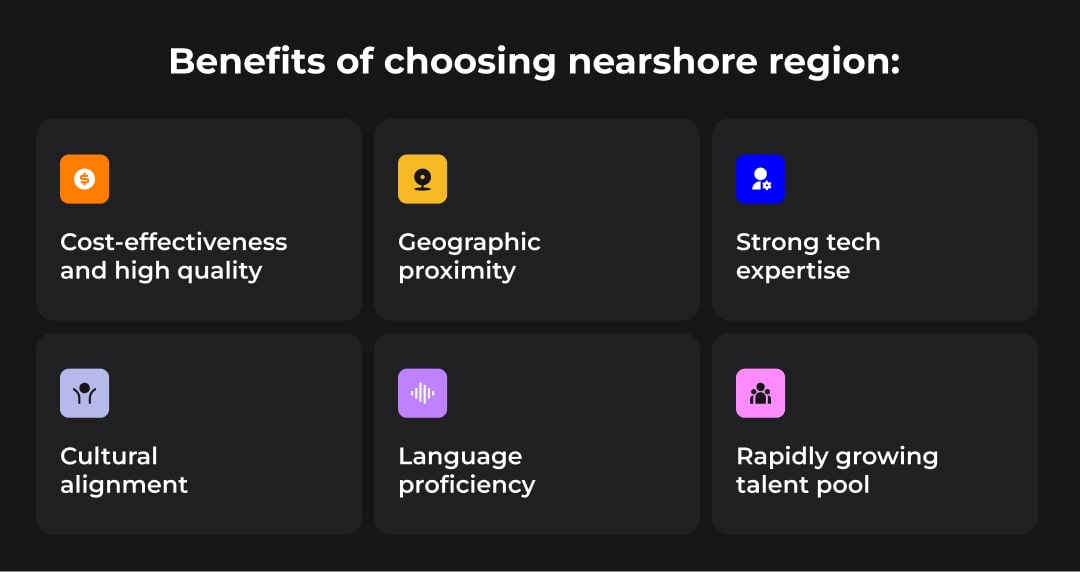The software salary in the US has surged over recent years, with senior engineers frequently earning $120K–$150K annually. With benefits, recruitment, and payroll contributions, total employer costs can exceed $180K per developer. SSON Research & Analytics shows that companies outsourcing IT functions achieve labor cost savings of 15–30%, while improving scalability and operational flexibility.
According to Deloitte’s 2025 Global Business Services Survey, Mexico ranks among the top three global service delivery locations, thanks to its scalable tech talent and competitive costs. LATAM developers consistently deliver fast, communicate clearly, and adapt quickly to U.S. product teams. The cost advantage is real, but it’s the ease of integration that makes this region a go-to for growing teams.
In this article, we’ll break down how Latin America compares to the U.S. across salaries, talent quality, and total cost of hiring, giving a clear roadmap to scale smarter by tapping into nearshore tech talent.
Why Companies Are Rethinking U.S.-Only Hiring
For many U.S. companies, the challenge is in finding talent and securing it fast enough and at a sustainable total cost. Hiring locally has become a slow, expensive, and uncertain process, especially for teams without the brand power or compensation flexibility of Big Tech.
Need to hire, but can’t afford to wait 40+ days or overpay for every role? Outstaff Your Team helps companies growing fast, with zero compromise on quality.
Check our nearshore services
The Hidden Cost of U.S. Tech Hiring
Extended time-to-hire (often 40+ days) slows product development.
Startups and mid-sized teams routinely lose candidates to better-funded competitors.
Rising salaries for IT professionals make budgeting unpredictable.
Churn and early exits increase onboarding and ramp-up waste.
Even when the annual salary for software developer roles seems justifiable, the total investment per hire often overshoots ROI, especially for growing teams with limited bandwidth.
Why LATAM Is Becoming the Default Plan B
According to the 2025 Kearney Foreign Direct Investment Confidence Index, Mexico and Brazil remain among the top investment destinations in Latin America, recognized for their strong economic performance and robust talent pipelines in IT and business services. This aligns with what we observe at Outstaff Your Team: a growing number of U.S.-based companies are turning to these markets not just to cut costs, but to access dependable talent and accelerate hiring cycles without compromising on team quality or collaboration.
The LATAM Advantage: Skilled, Aligned, Affordable
Latin America has moved beyond being a low-cost alternative. It’s now a core region for companies seeking fast, high-quality tech hiring. Engineers in Mexico, Brazil, Colombia, and Argentina are known for their technical strength, adaptability, and ability to work in sync with U.S. teams.
Stop chasing talent in oversaturated markets. Start building with LATAM experts who deliver.
Book a free hiring strategy call
Engineering Talent That Keeps Up
Over the past few years, we’ve seen Brazil and Mexico emerge as go-to markets for engineering talent because the developers coming out of these countries are genuinely strong. Many have solid STEM backgrounds, hands-on experience with U.S.-based product teams, and deep expertise in stacks like React, Node.js, Python, and .NET.
More recently, we’ve also noticed a sharp rise in AI/ML capabilities, especially among mid-level engineers. When companies turn to software development LATAM teams, it’s often about finding engineers who are already operating at the level they need, just in a different ZIP code.
Operational Efficiency Without Domestic Burn Rate
Beyond the well-known salary gap, companies increasingly value the working rhythm: real-time collaboration across U.S. time zones, high English proficiency, and familiarity with agile processes. Latin America software developers bring continuity, quality, and cultural fit that helps teams scale without slowing down.
Cost Comparison: Hiring in the U.S. vs. Latin America

If you're building a lean, high-performing tech team, understanding the true cost differences by role and seniority is essential. We compiled the following data from 2025 hiring cycles to offer a side-by-side view of market rates in the U.S. and LATAM.
Here's average monthly salaries by role & seniority in USD, based on 2025 internal research:
Position
Seniority
North America (avr. $, monthly)
LATAM (avr. $, monthly)
Java Developer
Junior
5200
1700
Middle
8300
2800
Senior
10400
3700
Python Developer
Junior
4125
1600
Middle
7875
2600
Senior
10625
3600
PHP Developer
Junior
4500
1400
Middle
6750
2200
Senior
9300
2800
JavaScript / Front-End Developer
Junior
5500
1500
Middle
7500
2200
Senior
9700
2700
Android Developer
Junior
6400
1800
Middle
8700
3000
Senior
10625
4200
iOS Developer
Junior
7600
2000
Middle
9750
3200
Senior
11100
4500
ML Engineer
Junior
8300
2200
Middle
11600
3400
Senior
18000
4700
Manual QA Specialist
Junior
5600
1300
Middle
7500
2100
Senior
10000
2800
IT Project Manager
Junior
6250
1500
Middle
8300
2300
Senior
10800
3200
Product Manager
Junior
6900
1800
Middle
9350
2600
Senior
12000
3500
UI/UX Designer
Junior
6200
1700
Middle
8500
2500
Senior
11000
3500
Graphic Designer
Junior
3600
1500
Middle
6000
2400
Senior
9500
3100
Digital Marketing Specialist
Junior
4375
1300
Middle
6375
1900
Senior
8750
2600
Content Writer
Junior
3250
1000
Middle
4375
1700
Senior
5625
2350
Business Development / IT Sales
Junior
4750
1525
Middle
6500
2400
Senior
9250
3425
Technical Support
Junior
4300
1000
Middle
5500
1500
Senior
7500
2200
After reviewing the numbers, three trends stand out:
The software engineer salary in the US continues to rise steeply, with senior roles averaging over $11,000/month, which is more than double compared to LATAM engineers earn.
In many cases, hiring one U.S.-based senior developer costs the same as assembling a small, agile LATAM team.
Mid-level and senior specialists, particularly QA and design, show some of the largest cost deltas, with savings nearing 70%.
With the average salary in Latin America still well below North America's levels, companies gain flexibility to scale output without compromising on skill or speed.
Total Cost of Hiring: What You’re Really Spending

When you hire a developer, the base salary is just the beginning. The real cost includes benefits, taxes, and operational overhead that often go underestimated.
In the U.S., employer costs typically rise by 30–50% on top of base pay. According to the U.S. Bureau of Labor Statistics (2025), benefits account for 29.4% of total compensation on average.
Add-ons include health insurance, 401(k) matches, paid leave, payroll taxes, and recruitment fees.
In LATAM, employer contributions are generally lower – 17–25% depending on the country, and often simplified when hiring via third parties or local partners.
Whether you’re managing full-time staff or negotiating project-based roles, understanding the hidden layers behind the software developer salary in US reshapes how you budget. It’s also critical when negotiating developer’s salary and planning for long-term team stability across borders, especially as salaries for IT professionals continue to trend upward.
Practical Realities: Risks and How to Navigate Them
International hiring always carries nuances, especially when working with emerging tech markets. That said, most of these risks are entirely manageable with the right model and local expertise. Here's what to look for and how to plan smart.
Strategy of Mitigating Risks
Many companies hesitate over areas like compliance or currency stability. We see businesses succeed when they treat these as operational factors to plan around rather than dealbreakers.
Risk Area
Typical Concern
Recommended Solution
Currency & Inflation
Fluctuations in local income value
Use USD contracts or regular cost-of-living reviews
Local Labor Laws
Restrictions like local subcontracting rules
Partner with a third party who manages Employer of Record (EOR) for compliance
Talent Turnover
Early job hopping post-hire
Invest in onboarding, L&D, equity options, or structured career paths
In high-volatility markets like Argentina, currency swings can erode take-home pay. That’s where structuring nearshore IT staffing in USD or indexing pay to inflation becomes practical and fair.
Mexico’s stricter subcontracting regulations can complicate freelancer-based models, but a trusted local EOR solves this once and for all.
The real talent risk isn't geography; it's retention. Offering clear development plans and meaningful local engagement helps reduce churn, even when competing global firms raise tech salary offers.
The Hidden Metric That Impacts Retention
Don’t just compare tech salary figures. Focus on real income vs nominal income, such as what developers actually take home after inflation, local taxes, and cost of living. In many LATAM markets, moderate nominal salaries offer strong real purchasing power. This leads to higher satisfaction and lower turnover, which in turn gives you team consistency and project continuity.
Hybrid Teams, Real Results
Many companies enter LATAM markets thinking it's just about cutting costs, but quickly realize it’s also about speed, continuity, and adaptability. We’ve worked with teams that were stuck in long hiring cycles at home and suddenly found themselves moving faster, with developers who understood the workflow from day one.
The teams that succeed long term design hybrid models where U.S.-based leads own strategy, and nearshore talent drives execution. When that balance clicks, teams build better, more predictably, with less friction and fewer false starts.
Ready to scale smart?
Drop us a line at hi@outstaffyourteam.com, and let’s map out the next chapter of your engineering team. Whether you're looking to reduce overhead without cutting quality or want to tap into top-tier nearshore talent for faster delivery, we’ll help you build a custom hiring strategy, from your first role to full hybrid delivery teams.
From Python developers and product designers to AI specialists and QA engineers, we’ll assemble the right mix of people who know how to ship, sync, and stay. Let's scale together — predictably, affordably, and with no shortcuts on quality.
FAQ
How do tech salaries in Latin America compare to those in the United States?
There’s a noticeable cost gap. Take a senior Python developer: in the U.S., that role often runs over $10000/month when you factor in market rates. In Latin America, the same level of talent typically costs around $3600/month. From our experience, that doesn’t mean lower quality. Many LATAM developers have worked with U.S. product teams before, speak fluent English, and are used to agile workflows. The salary gap reflects market dynamics, making it one of the most strategic hires you can make if you're scaling responsibly.
How is remote work affecting LATAM tech salaries?
Once remote work went mainstream, top LATAM engineers started getting multiple offers, often from U.S. startups willing to pay in dollars. That’s pushed salaries up, especially in markets like Colombia and Brazil. Still, compared to U.S. benchmarks, these roles remain cost-effective for employers. What’s interesting is that even with modest salary jumps, developers often see their quality of life improve significantly. It’s a win-win when compensation aligns with both local cost of living and global demand.
What are average salaries for software developers in top LATAM countries?
From what we’ve seen firsthand, senior developers in Mexico and Brazil typically earn between $4,500 and $5,500 per month, depending on their stack. Colombia and Argentina are slightly lower, usually in the $4,000 to $5,000 range. Junior and mid-level devs come in considerably lower, sometimes under $2,000/month for junior roles.
These numbers may look low from a U.S. perspective, but they’re competitive locally and attractive enough to retain talent, especially when paid in USD. We’ve found that offering stable, well-structured remote roles at the upper end of local salary bands builds loyalty and reduces churn, even in fast-moving markets.
Ann Kuss is the CEO at Outstaff Your Team. After 11 years of expertise in building remote tech teams for startup unicorns and global tech brands, Ann decided to lead a new venture aiming to reinvent the way international tech teams scale. Throughout her career, Ann hired specialists for countless tech positions from more than 17 countries on all major continents. Ann graduated from Kyiv-Mohyla business school, is an MIM Kyiv alumna, and regularly takes part in mentorship programs for junior tech talents. Ann actively promotes knowledge sharing and curates Outstaff Your Team blog strategy, preferring topics that solve practical needs of IT leaders. She believes that structuring business flows (including hiring) is a well-planned journey with predictable and successful outcome.



